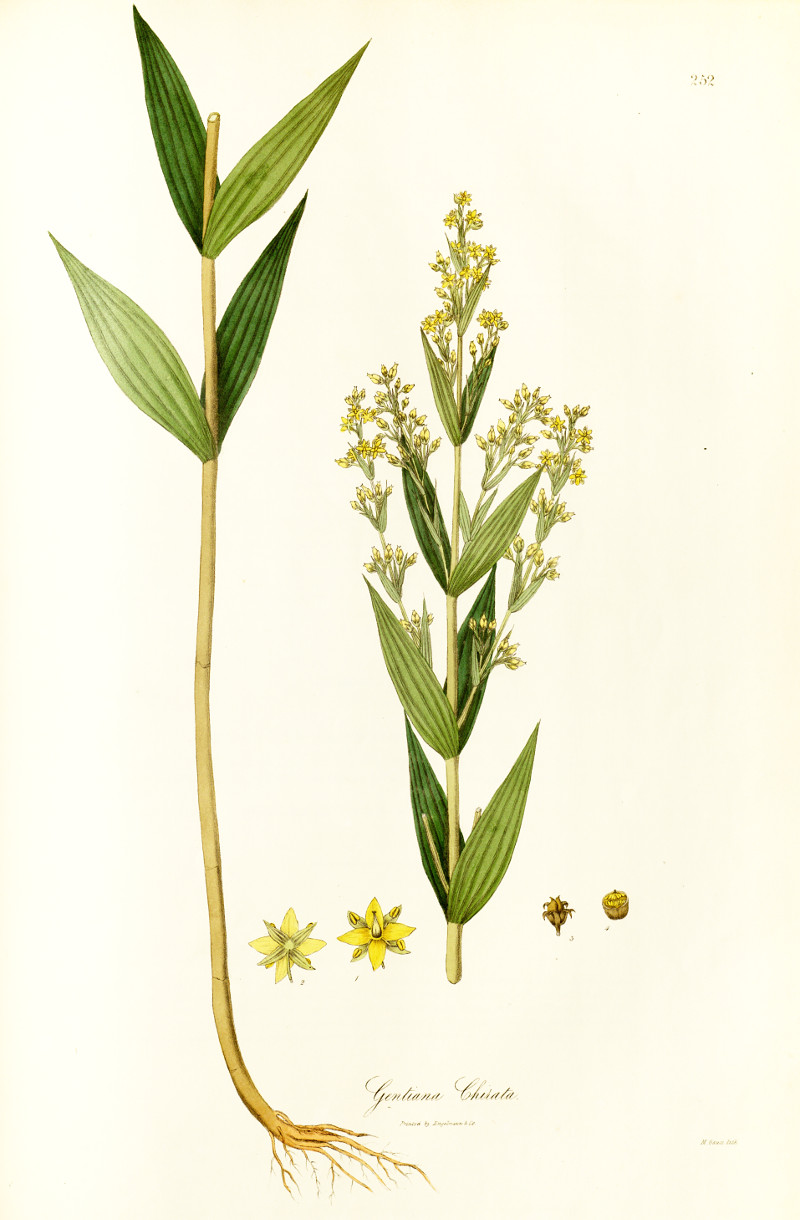Dies ist eine alte Version des Dokuments!
Swertia chirayita (Roxb.) H. Karst. - syn.Swertia chirata Ham.; Gentiana chirata Wall.; Gentiana chirayita Roxb - Gentianaceae
chirata (India), चिराईतेf chiraito (Nepal), chiretta, Chirettakraut
Erect annual or biennial herb, up to 90cm high, endemic to temperate Himalayas (India, Nepal, Bhutan); taproot short, simple; stem purplish or brown; flowers green-yellow, tinged with purple.
„Among the different species of Swertia reported in India, Swertia chirayita is considered the most important for its medicinal properties. The bitterness, antihelmintic, hypoglycemic and antipyretic properties are attributed to amarogentin (most bitter compound isolated till date), swerchirin, swertiamarin and other active principles of the herb. Herbal medicines… contain chirata extract in different amounts for its antipyretic, hypoglycemic, antifungal and antibacterial properties… The widespread use of S. chirayita in traditional medicine reflects its pharmacological importance. However, existing populations of S. chirayita are diminishing.
[Swertia chirayita- an overview., Joshi, P., Dhawan, V., Current Science -Bangalore-, Vol.89(4), 2005, 635]
http://tejas.serc.iisc.ernet.in/~currsci/aug252005/635.pdf
„Due to over-harvesting, lack in conservation and cultivation, this species is still in threat as categorized
vulnerable by International Union for Conservation of Nature (IUCN), (2000). Therefore sustainability of
production and marketing is the major concern along with the dissemination of cultivation technology…
Chiretta plants constitute two main intensely bitter principles, ophelic acid and chiratin both amorphous
and indistinctly crystalline yellow substances. Acceptable level of bitter principle content is above 1.3 %, which contains a bitter glycoside amarogentin, numerous tetra oxygenated xanthones including swertinin (7,8-dihydroxy 1,3-dimethoxyxanthone), swertianin (1,7,8-trihydroxy-3-methoxyxanthone), swerchirin (1,8-dihydroxy- 3,5-dimethoxyxanthone), decussarin (1-hydroxy 2,6,8-trimethoxyxanthone), isobelidifolin (1,6,8-trihydroxy-4-methoxyxanthone, 1,3,7,8-tetrahydroxyxanthones), 1,8-dihydroxy-3,7-dimethoxyxanthone, 1-hydroxy 3,5,8-trimethoxyxanthone, mangiferin (1,3,6,7-tetrahydroxyxanthon-c2-alpha-D-glycoside, and several other; triterpenes (luperol, alpha-amyrin, etc) and monoterpene alkaloids, among others…
The bitter principle as a main indicator of medical herbs, varied from 0.95 to 2.0% in the tested samples of
Chiraito. Higher bitter principle (2%) was found from wild Chiraito of 4 locations (Taplejung-Suketar and
Phawakhola site, Terhathum-Bhusune-Jiptare and Nuwakot). Pharmacopeial limit of bitter principle is 1.3%. Two other samples also crossed this limit (Dhading- Toplang 1.5% wild and Sindhupalchok- 1.5% cultivated).“
[Quality of Chiretta (Swertia chirayita) in Cultivated and Wild Samples Collected from Different Districts of Nepal., Barakoti, T.P., Tiwari, N.N., Yonzon, M., Nepal Journal of Science and Technology, Vol.13(2), 2013, 57-62]
http://www.nepjol.info/index.php/NJST/article/download/7715/6295

Swertia chirayita (Roxb.) Karsten [as Gentiana chirata]
Wallich, N., Plantae Asiaticae Rariores, vol.3: t.252 (1832) [n.a.]
http://plantgenera.org/species.php?id_species=988188
